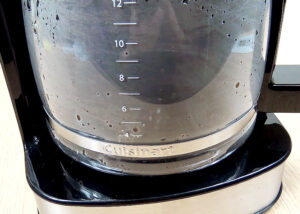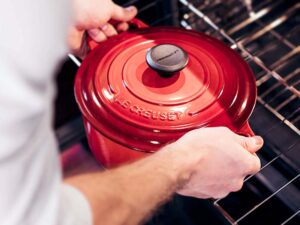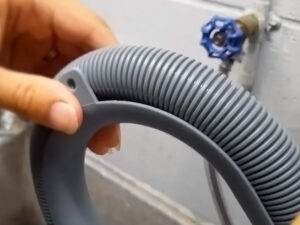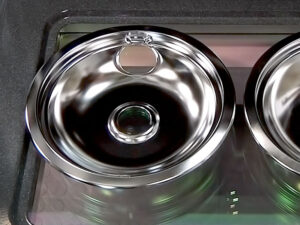Cleaning burnt sugar off your stove top can seem overwhelming, but don’t worry! There are effective ways to get your cooking space looking clean and shiny again. In this guide, we will show you how to clean burnt sugar from your stovetop. We’ll take you through each step, from checking the damage to selecting the right cleaning products. We will give you helpful tips, safety precautions, and recommended supplies to make cleaning easier and more efficient. Whether you’re dealing with a small spill or a tough, old residue, our tips will help you overcome the problem and keep your cooking area clean.
Evaluating the Damage: Determining the Amount of Burnt Sugar
When you see burnt sugar on your stovetop, the first important thing to do is evaluate the extent of the damage. The burnt sugar residue can vary in severity, from a light caramelization to a thick, stubborn layer that appears bonded to the surface. To determine the best way to clean, it’s important to understand how much the sugar has burned.
Start by looking closely at the areas that are affected. Please observe and record the color, thickness, and distribution of the burnt sugar. A light caramelization can look like a thin film, while a more severe case can have a thick, dark layer that covers more of the stovetop. This visual assessment will help you determine the amount of effort and specific cleaning methods required.
Now, evaluate the texture of the caramelized sugar. Is it sticky and tacky, or has it formed a hard crust? The texture affects which cleaning agents and tools to use. If there are sticky residues, you might need a degreasing agent. On the other hand, if there is hardened sugar, a gentle abrasive method could be necessary.
Think about the type of stovetop surface you have. Every type of surface, whether it’s made of glass, ceramic, or metal, has specific cleaning needs. Glass and ceramic surfaces can be easily scratched, so they need to be handled with care. On the other hand, metal surfaces can handle slightly more abrasive cleaning methods.
Check if the burnt sugar has gone inside. Sometimes, sugar can get into small spaces or around the burners. If the burnt sugar has spread to these hard-to-reach areas, you may need to clean more carefully. This might involve taking apart certain parts of the stove for a thorough cleaning.
Another thing to think about is how old the burnt sugar deposits are. Cleaning fresh spills is usually easier than removing older, hardened residues. If the burnt sugar has been on the stovetop for a long time, it might take longer and need more effort and specific cleaning products to remove it.
After you have evaluated the extent of the damage, you can create a specific plan for cleaning. To lightly caramelize, you can simply wipe it down with a damp cloth. However, if the burnt sugar is stubborn and extensive, you may need to use specific cleaning agents and tools in a multi-step approach.
Getting the Necessary Supplies: Tools and Materials for Efficient Cleaning
Having the right tools and materials is important for effectively cleaning burnt sugar off your stovetop. Before you start cleaning, make sure you have the necessary supplies to do a thorough and efficient job.
- Soft Cleaning Cloths or Sponges: Opt for non-abrasive materials to avoid scratching the stove top surface. Microfiber cloths or soft sponges are excellent choices for gentle yet effective cleaning.
- Cleaning Agents: Depending on the severity of the burnt sugar, you may need different cleaning agents. For light residues, a mixture of water and vinegar can suffice, while tougher stains may require specialized stove top cleaners or degreasers. Check the compatibility of the cleaning agents with your stove surface.
- Plastic or Wooden Scraper: For stubborn, stuck-on burnt sugar, plastic or wooden scraper can help gently lift the residue without causing damage. Avoid metal scrapers, as they may scratch the stovetop.
- Baking Soda: This versatile household item acts as a mild abrasive and can aid in scrubbing away burnt sugar deposits. Create a paste by mixing baking soda with water for targeted application.
- Protective Gloves: Since cleaning agents may contain chemicals, it’s wise to protect your hands with gloves. Choose gloves that are resistant to cleaning solutions to ensure safety.
- Bucket of Warm, Soapy Water: Having a bucket of warm, soapy water nearby is convenient for rinsing and cleaning your cleaning tools during the process.
- Stove Component Removal Tools (if applicable): If your stove allows for the removal of certain components, such as burner grates or drip pans, have the necessary tools ready for a more comprehensive cleaning.
By gathering these necessary supplies, you are preparing for a successful and efficient burnt sugar cleaning operation. By using the correct tools and cleaning agents, you can safely remove burnt sugar from your stove top without causing any damage.
Removing Burnt Sugar Stains Methodically: Easy-to-Follow Cleaning Guide
To effectively clean burnt sugar stains on your stovetop, it’s important to follow a systematic approach that won’t harm the surface. Use this easy-to-follow guide to clean your space effectively and efficiently.

Step 1: Prioritize Safety by Creating a Secure Cleaning Environment
When cleaning a stove top, safety should be the most important thing to consider. Start by switching off the stove and unplugging it. Make sure to let the stove top cool down completely before you start cleaning it to avoid getting burned or injured. This safety measure ensures a secure environment for you to effectively remove burnt sugar stains without risking your safety.
Step 2: Evaluating the Damage – A Thorough Analysis of Burnt Sugar Residue
Based on the initial assessment, now conduct a more thorough examination of the burnt sugar residue on your stovetop. Examine the color, thickness, and distribution of the burnt sugar carefully to fully understand how difficult the cleaning task is. By examining the burnt sugar more closely, you can adjust your cleaning method to match its specific characteristics. This includes determining if it is lightly caramelized or a thicker, more stubborn layer.
Step 3: Get the Necessary Supplies – Prepare yourself for success
Before you start cleaning, gather all the necessary supplies. You will need some soft cleaning cloths or sponges to avoid scratching, cleaning agents that match the severity of the stains, plastic or wooden scraper for tough deposits, baking soda for its gentle abrasiveness, protective gloves for safety, a bucket of warm, soapy water to rinse your tools, and, if necessary, tools to remove stove components for a deeper clean. By preparing carefully, you will have everything you need to effectively address burnt sugar stains.
Step 4: Remove Loose Debris – Prepare the surface for cleaning
Before you use any cleaning products, use a soft cloth or sponge to remove any loose debris from the stovetop. This first step helps remove any dirt on the surface so that the cleaning process can be more focused and effective. To start, remove any loose debris. This will help prepare for a thorough cleaning and allow the cleaning agents to better penetrate the burnt sugar stains.
Step 5: Apply Cleaning Agent – Selecting the Appropriate Solution
Choosing the right cleaning product is crucial for your cleaning task to be successful. To remove lighter stains, mix equal parts water and vinegar in a spray bottle. If the stains are difficult to remove, use stove top cleaners or degreasers made specifically for this purpose. Follow the instructions on the product for best results. To remove burnt sugar stains, generously apply the cleaning agent and let it sit for a few minutes. This will help the solution penetrate and loosen the burnt sugar, making it easier to remove.
Step 6: Use a Soft Cloth or Sponge to Gently Scrub the Surface
Once you have your preferred cleaning agent, use a soft cloth or sponge to gently scrub the burnt sugar stains. You can scrub in either circular or back-and-forth motions. Apply gentle pressure, adjusting as needed depending on how severe the stains are. To remove stubborn burnt sugar, use a plastic or wooden scraper to lift it off the stovetop without damaging the surface.
Step 7: Use Baking Soda to Remove Stubborn Stains
To remove tough stains that won’t go away easily, use baking soda, which has gentle abrasive qualities. Make a paste by combining baking soda and water, then put it on the burnt sugar stains. Let the baking soda paste sit for a few minutes, then scrub the area with a soft cloth or sponge. Adding this extra step helps to focus on difficult areas and ensures a more thorough approach.
Step 8: Repeat the Process Patiently
Once you’ve finished scrubbing, rinse the stove top with clean water. It is important to do this step in order to completely remove any remaining cleaning agent or baking soda. You may need to clean the stains multiple times, depending on how severe they are. Being patient is important when trying to clean thoroughly and effectively. You may need to repeat the process several times, especially if dealing with stubborn or old burnt sugar stains.
Step 9: Dry the Stovetop to Avoid Future Problems
After successfully removing the burnt sugar stains, use a clean, dry cloth to thoroughly wipe down the stovetop. It’s important to make sure the surface is completely dry to prevent any remaining moisture that could cause problems or water stains later on. This last step ensures that your stovetop is not only clean but also protected from potential issues.
Step 10: Cleaning Removable Components
If your stove has removable parts like burner grates or drip pans, take advantage of this chance to clean them thoroughly. Take out these parts and clean them individually using the same cleaning agents and tools. This makes sure that each part of your stove gets the attention it needs, resulting in a more thorough and even cleaning process overall.
Step 11: Polish the Stovetop to Give it a finishing touch (If desired)
If you want your stovetop to shine more, try polishing it. You can either use a stovetop polish or make a mixture of vinegar and water for this optional step. Polishing the stove top not only makes it look better but also adds a final touch to the cleaning, leaving your cooking area clean and shiny.
Step 12: Avoiding Future Incidents
Now that your stovetop is back to its original, clean condition, let’s shift our attention to avoiding any more accidents with burnt sugar in the future. Make it a habit to wipe down your kitchen after each use to prevent residue buildup. Also, be cautious when using cookware and utensils to prevent spills and splatters, which will help keep your stovetop clean for a longer time.
You can effectively remove burnt sugar stains from your stove top by carefully following this cleaning guide. Make sure to adjust your cleaning method depending on how bad the stains are and what kind of stove surface you have. This will help you clean it safely and effectively.
Selecting the Correct Cleaning Products: Efficient Methods for Removing Burnt Sugar
Choosing the right cleaning products is an important part of getting rid of burnt sugar on your stovetop. The cleaning solution you choose depends on how badly the sugar is burnt, the type of stove surface, and whether you prefer natural or commercial cleaning products. Here are some effective ways to remove burnt sugar:
A Mixture of Vinegar and Water
To remove lighter burnt sugar stains and for regular cleaning, you can use a mixture of equal parts water and vinegar. This natural solution combines vinegar’s degreasing and mild acidic properties in a spray bottle. When you spray the mixture onto the burnt sugar stains, it goes deep into the stains and breaks them down. This makes it easier for you to wipe them away using a soft cloth or sponge. This method works well for regular cleaning tasks and mild cases of burnt sugar buildup.
Specialized Stove Top Cleaners
If you have tough or severe burnt sugar stains, it’s a good idea to use specialized stovetop cleaners. These cleaners are specifically made for stove tops and have strong degreasers and surfactants to remove stubborn residues. To use the cleaner, just follow the instructions on the label. Apply the solution directly to the stains and let it sit for a specific amount of time. Then, scrub the stains with a soft cloth or sponge. This method works well for stubborn burnt sugar deposits that need a stronger and more focused approach.
Degreasers
To remove tough, greasy burnt sugar stains, using a degreaser is a good cleaning choice. These strong solutions are good at breaking down tough, sticky residues that might not be easily cleaned by regular cleaning products. To remove burnt sugar stains, apply the degreaser directly. Let it sit for a few minutes, then scrub gently with a soft cloth or sponge. This method is very useful for tough cleaning tasks because it effectively removes stubborn residues.
Baking Soda Paste
To remove stubborn burnt sugar stains and use a gentle abrasive, you can make a paste with baking soda. To remove burnt sugar stains, make a paste by mixing baking soda and water. Letting the paste sit for a short time helps the baking soda’s gentle abrasive properties to break down and remove stubborn residues. After scrubbing with a soft cloth or sponge, you will have a clean and refreshed stove top. This method works well for people who like using natural cleaning options.
Commercial Ceramic Cooktop Cleaner
It is wise to choose a commercial ceramic cooktop cleaner when cleaning ceramic or glass stovetops. These cleaners are made to be gentle on surfaces and effectively clean without causing scratches. By following the product instructions, you can clean carefully and effectively. Usually, this involves applying the product, waiting for a bit, and then wiping it off with a soft cloth. This method is important for keeping ceramic or glass stove tops clean and looking good.
Lemon Juice
Lemon juice is a great natural way to remove light burnt sugar stains. It has a pleasant aroma and works effectively. Fresh lemon juice is acidic, which helps break down stains. It also has a natural fragrance that leaves a refreshing scent. Just squeeze some fresh lemon juice onto the burnt sugar stains, let it sit for a bit, and then scrub gently with a soft cloth or sponge. This method is great for people who like using natural cleaning solutions and want their kitchen to smell fresh and citrusy.
Before using any cleaning product, make sure to refer to the guidelines provided by the stove manufacturer to see which cleaning products are recommended and safe to use. Try out these solutions depending on how severe the burnt sugar is on your stovetop. Remember to test a small area first to make sure the cleaning agent won’t harm the surface. With the correct cleaning agents, you can confidently move on to the next steps of cleaning.
Maintenance Tips for a Clean Stove Top
Keeping your stovetop clean involves more than just removing burnt sugar stains. It also means taking proactive steps to prevent future incidents and preserving the pristine condition of your cooking area. Here are some helpful tips to keep your stovetop clean and free from tough stains.
Regular Wipe-Downs
Make it a habit to clean your stovetop after every time you cook. Removing spills, splatters, and food residues quickly prevents them from becoming hard or caramelizing on the surface. To prevent difficult cleaning, use a gentle cleaning solution and a soft cloth or sponge to handle small messes promptly. Developing this simple habit can greatly help in keeping your stovetop clean in the long run.
Choose Cookware Wisely
The cookware you use can affect how likely spills and burnt residues are on your stovetop. Choose cookware that has flat bottoms and secure lids to reduce the chance of spills. Don’t use cookware with rough or uneven surfaces that could scratch the stovetop. Using lids while cooking also helps to keep splatters contained and prevents food particles from sticking to the stove surface.
Monitor Heat Levels
It is important to control the heat levels when cooking to avoid burning the sugar. When it gets really hot, things can caramelize quickly and become harder to clean up. Please adjust the heat settings based on your cooking requirements and use low to medium heat whenever you can. Being mindful of heat levels helps prevent burnt sugar and also prolongs the life of your stovetop.
Use Protective Liners
You may want to use protective liners or mats that are specifically made for stovetops. These can act as an extra layer between your cookware and the stove surface. They catch spills and prevent direct contact with the burner areas. Protective liners are simple to clean and can help keep your stovetop tidy and free from stains.
Clean Burner Components Regularly
Make sure to regularly clean the removable components of your stove, such as grates, burners, and drip pans. Grease and food residues can build up on these components, which can lead to incidents of burnt sugar. Follow the instructions provided by your stove to remove the parts, and clean them thoroughly using appropriate cleaning agents. Keeping the burner components clean helps the stove work better and prevents spills from causing problems on the stovetop.
Avoid Harsh Cleaning Agents
It’s important to use effective cleaning products for removing burnt sugar stains, but be careful not to use harsh or abrasive chemicals too often. Using these chemicals can gradually harm the surface of your stovetop. Use gentle cleaners that are safe for stove-top cleaning for regular maintenance. If you’re unsure, just check the guidelines provided by your stove manufacturer for the cleaning products they recommend.
Stay Attentive During Cooking
To avoid burnt sugar accidents, it’s important to pay attention while cooking. Make sure to always stay near the stove, especially when using high heat. To prevent stubborn stains, quickly deal with spills or boil-overs. Taking proactive steps in the kitchen can greatly reduce the chances of dealing with burnt sugar issues.
Implement a Deep Cleaning Schedule
Alongside regular wipe-downs, make sure to include a deep cleaning schedule as part of your kitchen maintenance routine. Regularly, make sure to remove the burner components, clean underneath them, and deal with any built-up residues. A deep cleaning session makes sure that hidden areas are cleaned really well so that burnt sugar doesn’t build up over time.
By following these maintenance tips in your kitchen routine, you can keep your stovetop clean and help your cooking appliance last longer and work more efficiently. Taking proactive measures and regularly cleaning your kitchen can help prevent burnt sugar incidents and improve the overall appearance and functionality of your kitchen.
Frequently Asked Questions
How frequently should I clean my stove top thoroughly?
How often you need to deep clean your stove top depends on how often you cook and how much you use it. If you cook often and use different ingredients, cleaning thoroughly every two to three weeks is usually enough. If you cook with high heat or have spills and splatters often, you might need to clean more often. Regularly cleaning your stove top not only keeps it looking nice but also helps it work better and prevents stubborn residue buildup.
Can I use the same cleaner for all types of stove tops?
It’s important to consider the type of stovetop you have, as different materials may need different cleaning methods. It’s important to follow the guidelines from your stove’s manufacturer when using cleaning agents, even if some can be used on different surfaces. Glass and ceramic surfaces can easily get scratched, so it’s better to use gentle cleaning solutions. However, metal surfaces can handle stronger cleaning agents. Following the manufacturer’s recommendations will help you clean your stovetop effectively and avoid any potential damage.
What can I do to avoid scratches on my glass or ceramic stove top?
To prevent scratches on glass or ceramic stove tops, you need to be careful and adopt certain practices. Do not use rough materials or harsh scouring pads, as they can cause permanent marks on the surface. Choose cookware with smooth and flat bottoms to avoid scratching. Lift pots and pans instead of sliding them across the surface. Also, remember to be careful with utensils that have rough edges that could potentially cause harm. You can keep your glass or ceramic stove top in good condition by following these precautions while cooking.
What should I do if burnt sugar has spilled under the burners or onto internal parts?
If burnt sugar has gotten under the burners or onto internal parts, it’s important to refer to your stove’s user manual for instructions on how to safely remove the burner components. To disassemble, follow the recommended steps. After removing, clean the affected areas using appropriate cleaning agents and tools. If you’re not sure about the process or don’t feel comfortable handling internal components, it’s a good idea to get professional help. They can make sure the cleaning is done properly and safely.
Are there any environmentally friendly options for removing burnt sugar stains?
Yes, there are many eco-friendly options available for cleaning burnt sugar stains that are both effective and good for the environment. Baking soda is a mild abrasive substance that can be mixed with water to make a paste. This paste can be used as a natural scrubbing solution. White vinegar is another eco-friendly option because it has degreasing properties. Moreover, the acidity of lemon juice can assist in removing stains and leave behind a pleasant citrus fragrance. These natural alternatives can effectively remove burnt sugar residues and also help you clean your kitchen in a greener and more sustainable way.
Can I use a razor blade to remove tough burnt sugar stains?
It is not recommended to use a razor blade to remove burnt sugar from your stovetop, especially if it is made of glass or ceramic. Although a razor blade may appear to be a strong tool, it has the potential to create permanent scratches and damage the surface. Instead, choose softer materials like plastic or wooden scrapers that are specifically made for stovetops. These materials can remove residues from your stove top without damaging the surface. This will keep your stove top free from stains and scratches.







